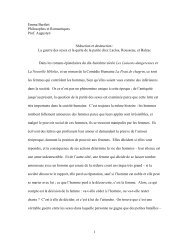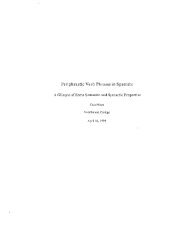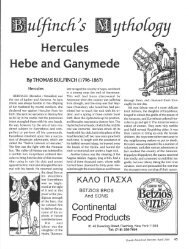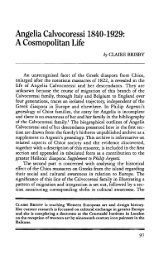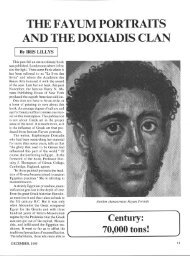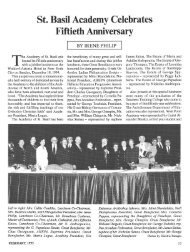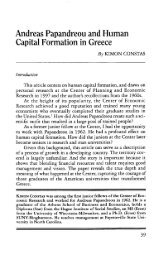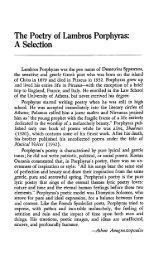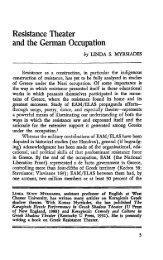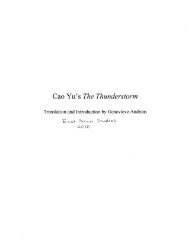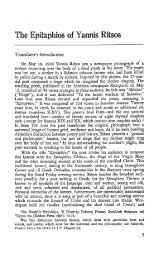Translating Neruda: Femininity and Sensuality ... - Triceratops Home
Translating Neruda: Femininity and Sensuality ... - Triceratops Home
Translating Neruda: Femininity and Sensuality ... - Triceratops Home
You also want an ePaper? Increase the reach of your titles
YUMPU automatically turns print PDFs into web optimized ePapers that Google loves.
Mueller 18<br />
“dedos / de música” which first gently lift a leaf, but then give “fuerza a los ríos” <strong>and</strong><br />
nearly destroy the earth. Again, though, water is depicted as the saving force here, with<br />
“lluvia, / lluvia verde, / lluvia llena / de sueños” nurturing the natural world into growth<br />
<strong>and</strong> new life <strong>and</strong> inspiring the speaker to love.<br />
The very end of the poem reads not so differently from the end of “Entrada a la<br />
madera,” as the reader entreats the storm to “cuenta conmigo” <strong>and</strong> “muéstrame tu camino<br />
/ para que a ti se junte y cante con tu canto / la decidida voz / tempestuosa de un<br />
hombre.” We return here to the relationship of the speaker <strong>and</strong> the subject-as-lover,<br />
again representing love of nature in a very physical, concrete way. But this relationship<br />
is complicated by the uncertain role that male <strong>and</strong> female will play in the uniting of their<br />
two voices. On the one h<strong>and</strong>, it could be an attempt at egalitarianism, with the male<br />
speaker suggesting that he will follow the path set out for him by the female storm. But it<br />
could also be read as an attempt to regain control over the storm, with his “decidida voz”<br />
taking precedence over the voice of the storm.<br />
<strong>Neruda</strong> further personifies water as a woman <strong>and</strong> a lover in the multi-part<br />
“Oceana,” published as part of Cantos Ceremoniales in 1961. This poem sees a return to<br />
the dependent narrator of <strong>Neruda</strong>’s much earlier work, as in “Poema 7,” who is<br />
interestingly positioned opposite not a human woman, but the sea herself, embodied as<br />
“Oceana,” a feminine adaptation of the masculine word for ocean, “océano.” Separated<br />
into eleven numbered sections, the poem seems to chronicle a story over the passage of<br />
time. The very first lines of the first segment situate the ocean in a human situation,<br />
calling her “Oceana nupcial.” By placing her “aquí a mi lado” shortly after calling her a<br />
bride, the narrator establishes an intimate relationship between the two, <strong>and</strong> subsequently



